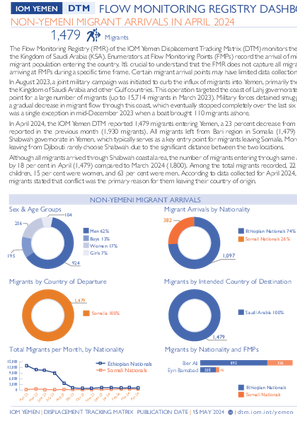-
Countries
-
Data and Analysis
-
Special Focus
-
Crisis Responses
Yemen - Flow Monitoring Registry | Non-Yemeni Migrant Arrivals and Yemeni Migrant Returnees in April 2024

Contact
IOM DTM Yemen, iomyemendtm@iom.int
Language
English
Location
Yemen
Period Covered
Apr 01 2024
Apr 30 2024
Activity
- Flow Monitoring
The Flow Monitoring Registry (FMR) of the IOM Yemen Displacement Tracking Matrix (DTM) monitors the arrival of migrants along Yemen’s southern coastal border and the repatriation of Yemeni nationals along its northern border with the Kingdom of Saudi Arabia (KSA). Enumerators at Flow Monitoring Points (FMPs) record the arrival of migrants and the return of Yemeni nationals to identify various migration patterns and provide quantitative estimates of the irregular migrant population entering the country. It’s crucial to understand that the FMR does not capture all migration flows in Yemen; instead, it provides indicative insights into migration trends based on an unknown total number of migrants arriving at FMPs during a specific time frame. Certain migrant arrival points may have limited data collection due to access constraints.
In August 2023, a joint military campaign was initiated to curb the influx of migrants into Yemen, primarily those en route to the Kingdom of Saudi Arabia and other Gulf countries. This operation targeted the coast of Lahj governorate, a major entry point for a large number of migrants (up to 15,714 migrants in March 2023). Military forces detained smugglers and chased their boats, leading to a gradual decrease in migrant flow through this coast, which eventually stopped completely over the last six months. There was a single exception in mid-December 2023 when a boat brought 110 migrants ashore.
In April 2024, the IOM Yemen DTM reported 1,479 migrants entering Yemen, a 23 percent decrease from the total figure reported in the previous month (1,930 migrants). All migrants left from Bari region in Somalia (1,479) and arrived in Shabwah governorate in Yemen, which typically serves as a key entry point for migrants leaving Somalia. Moreover, migrants leaving from Djibouti rarely choose Shabwah due to the significant distance between the two locations.
Although all migrants arrived through Shabwah coastal area, the number of migrants entering through same area decreased by 18 per cent in April (1,479) compared to March 2024 (1,800). Among the total migrants recorded, 22 per cent were children, 15 per cent were women, and 63 per cent were men. According to data collected for April 2024, 74 per cent of migrants stated that conflict was the primary reason for them leaving their country of origin.
The DTM team identified 5,046 Yemeni returnees in April 2024, a 19 percent increase compared to the number of returnees in March (4,226 individuals). Additionally, the team also recorded total of 191 migrants that were deported from Oman back to Deifen Point in Shahan district of Al Maharah governorate, Yemen. All deported migrants from Oman were Ethiopian nationals.
The worsening humanitarian crisis in Yemen has compelled many migrants to make difficult decision to return to their home countries in the Horn of Africa, some have reportedly been deported by authorities. In April 2024, the DTM recorded a total of 819 migrants leaving Yemen either voluntarily or were deported by boat from Yemen. This group was composed of 91 per cent men, eight per cent women, and less than one per cent children.
Furthermore, in April 2024, the Djibouti DTM team reported a total of 631 migrants (93% men, 4% women, and 3% children) arrived in Djibouti from Yemen after undertaking a perilous journey back home. These figures underscore the significant challenges migrants in Yemen face and the desperate circumstances that have led them to risk dangerous sea voyages.
